

Dr Rajendra Prasad was the first President of India. How many of us, other than Biharis, know that he was a Kayastha? That may raise another question, who is a Kayastha? The Kayasthas constitute an intermediate caste with a small presence in states like Uttar Pradesh and Bihar.
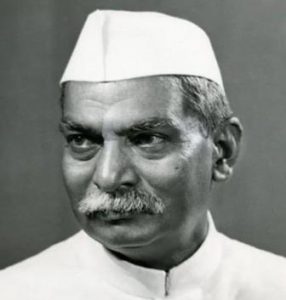
They were the first among the Hindus to take advantage of education. They were employed in large numbers by the Mughals and, later, by the British. They have a disproportionate presence in the Indian civil services like the IAS and the IPS.
Among the prominent Kayasthas are Amitabh Bachchan, Shatrughan Sinha and Yashwant Sinha. Nobody remembers Dr Prasad as a Kayastha. He became President by virtue of the services he rendered during the freedom struggle. His autobiography, translated into Malayalam, was one of the first I read.
The role he played in bringing succour to the people of Bihar who were hit by a devastating earthquake, which Mahatma Gandhi described as the result of God’s wrath over the ill-treatment of Scheduled Castes, alone was sufficient to make him the First Citizen.
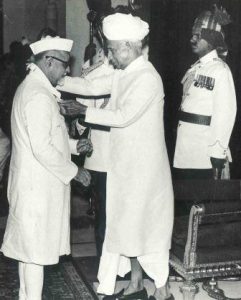
Dr. Sarvepalli Radhakrishnan was a South Indian Brahmin. When I read his two-volume ‘Indian Philosophy’, I was so influenced that I wanted to take philosophy as my subject. Since a degree course in philosophy was not available in the nearby colleges, I chose, instead, English literature as my main subject.
He was also an educationist having held the post of vice-chancellor of Banaras Hindu University. He also headed a national education commission. Another great educationist was Dr Zakir Hussain. Nobody referred to him as a Muslim. Nobody checked whether he was a Sunni or a Shia. What mattered was his competence to hold the post.
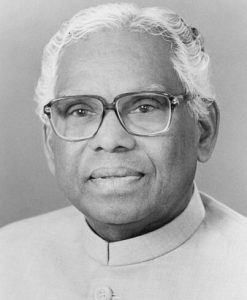
When the Congress nominated K.R. Narayanan to the posts of Vice-President and, later, President, nobody saw him as a Scheduled Caste.
An alumnus of the London School of Economics, who was India’s Ambassador to China and the USA, he was one of the greatest Presidents India had. He was also a Member of Parliament and Union Minister.
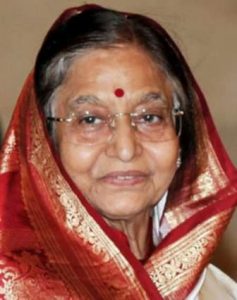
When a lady, Pratibha Patil, was chosen by the Congress as its Presidential candidate, Shiv Sena chief Bal Thackeray announced his support for her, because she was a Maharashtrian.
It was, perhaps, the first time sectarian considerations began to surface in the presidential elections.
When P.A. Sangma was fielded against Pranab Mukherjee, he did not get any extra vote because he was a Scheduled Tribe. He was no doubt a good candidate having established his credentials as one of the most popular Speakers of the Lok Sabha.
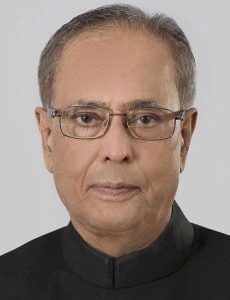
In comparison, Mukherjee was a much taller politician. He got more votes than expected.
When another former Speaker, Meira Kumar, was fielded as the Congress candidate, the BJP chose another Scheduled Caste member as its candidate.
It was the first time most people heard about Ram Nath Kovind. He won the election hands down because the BJP had the requisite votes to have him elected to the Rashtrapati Bhavan.
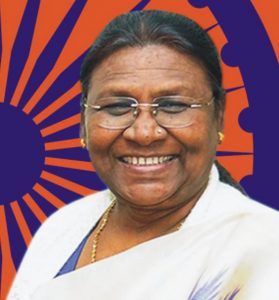
It now transpires that Draupadi Murmu, who is likely to be the 16th President of India, was also considered as a candidate by the BJP in that election. It was she who first disclosed this information a few days ago.
In retrospect, the BJP’s much-publicised attempt to consult the Opposition on a common candidate was just a farce. It already had its candidate ready to be fielded.
This time, the Opposition was the first to announce its joint candidate. It did so through a process of elimination.
Two persons publicly refused to be the Opposition’s presidential candidate. They were former Jammu and Kashmir Chief Minister Farooq Abdullah and former West Bengal Governor and Mahatma Gandhi’s grandson Gopalkrishna Gandhi. Finally, the combined Opposition chose Yashwant Sinha as its candidate.
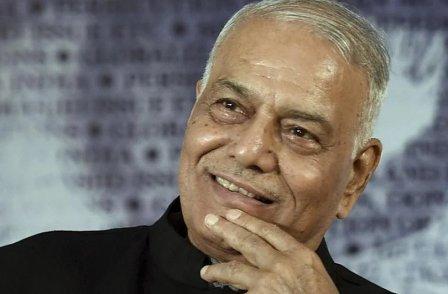
Sinha is a former IAS officer from Bihar who resigned from his post to try his luck in politics. He did remarkably well, becoming an MP from Hazaribagh. He went on to become Union Finance Minister. As a politician, he was not principled in the sense that he had no compunction in leaving one party to join another.
He was with the BJP and when he realised that Narendra Modi had no use for him like Nehru had no use for ex-ICS officers, notwithstanding some exceptions, he left the party and resorted to many political dramatics. He also ensured that his son remained in the BJP. He was a minister in the Modi government.
Nobody knows why and how he landed in the Trinamool Congress. West Bengal Chief Minister Mamata Banerjee was on the lookout for some successful “all-India” leaders. That is how she fielded Shatrughan Sinha from Asansol Lok Sabha seat in a recent by-election. When other Opposition parties wanted Sinha to resign from the TMC to become the joint Opposition’s presidential candidate, he had no hesitation in doing so.
Sinha is an octogenarian. He is at least one generation senior to Murmu. Whether he would make a better President than the lady is wholly debatable. As things stand, he has not been able to get the support of all the Opposition parties. Neither Bihar nor Jharkhand considers Sinha as the son of the soil.
Even in Kerala where he was expected to get 100 percent votes as both the UDF and the LDF support him, it would not be a surprise if Murmu gets some votes.
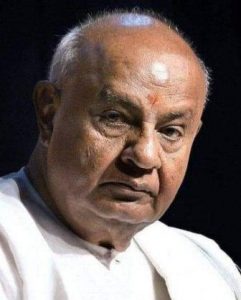
Former prime minister Deve Gowda, who was himself an aspirant for the post, has endorsed Murmu’s candidature saying that she was eminently suited for the job. His party men in Kerala may vote for him.
Here it would be appropriate to narrate a story. When Gowda was the prime minister, an IAS officer from Odisha was invited by his son for a breakfast meeting with the Prime Minister. He was a tribal and the first to become an IAS officer from his community. He was a Catholic.
Over soft iddli, crisp vada, spicy sambar and coconut chutney, Gowda told the IAS officer that he was going to make him the Cabinet Secretary. Until then, no Scheduled Caste or Scheduled Tribe member had become a Cabinet Secretary.
Every IAS officer aspires to become the Cabinet Secretary but only a few like T.N. Seshan become one. The tribal officer was so overjoyed that he could not believe what he heard. He considered it as a Providential blessing.
He was expecting the official order when he got another call from Gowda’s son, who later became chief minister of Karnataka. He told him that there was some problem in making him the Cabinet Secretary. He was told that he could get any ministry, including defence as a substitute.
He thought for a while and chose the rural development ministry. As he told me, “as Secretary, Rural Development, I could do some work for my community”.
Who was chosen as the Cabinet Secretary? He was a South Indian Brahmin, whose case was recommended by none other than a Shankaracharya. So much for Gowda’s love for the tribals!
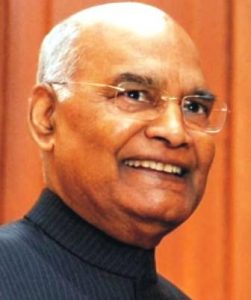
Since Ram Nath Kovind’s main qualification was that he was a Scheduled Caste, a question that naturally arises is whether his Presidency has helped the Dalits in any manner?
Was there at least a reduction in the number of atrocities committed on the SCs? The ban on cow slaughter has adversely affected tens of thousands of SCs employed in the tannery industry.
Many of them cannot even skin animals for fear that they would be accused of cow slaughter and lynched to death. Kovind’s greatest achievement as President is that he never delayed any Bill presented to him. It was with alacrity that he signed the controversial farm Bills forcing millions of farmers to protest.
True, the President’s post is ornamental. A former presidential candidate, Justice V.R. Krishna Iyer, described it as a gilded cage! He functions on the advice of the Council of Ministers. He has very limited powers of his own. He can, of course, counsel the government, send back the Bills for reconsideration and speak the mind of the nation when he finds that those in power are no longer upholding the Constitutional values.
K.R. Narayanan and Zail Singh are two Presidents who refused to be just signing instruments. Even Pranab Mukherjee had a mind of his own and he could not be taken for granted.
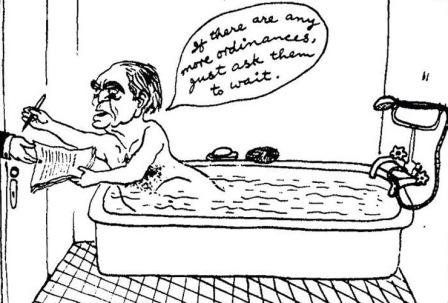 Kovind, alas, proved to be like Fakhruddin Ali Ahmed, whom cartoonist Abu Abraham caricatured as signing ordinances from his bathtub during the Emergency.
Kovind, alas, proved to be like Fakhruddin Ali Ahmed, whom cartoonist Abu Abraham caricatured as signing ordinances from his bathtub during the Emergency.
The National Democratic Alliance (NDA), led by the BJP, thinks that it has made a political statement by making Draupadi Murmu as its presidential candidate. True, she was a minister in Odisha when the BJP and the Biju Janata Dal shared power in the state. It was during that period that the Kandhamal riots happened.
In the name of avenging the killing of Swami Lakshmanananda, thousands of innocent Christians were hounded out of their homes. Their houses and churches were demolished. They became refugees in their own land.
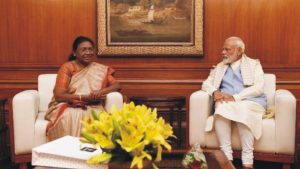
I do not think Murmu, who was a minister, did anything worthwhile to stop the persecution. She remained part of the government when the once proud tribals were forced to survive on the largesse of the noble-minded.
The tribals are considered the Adivasis because they are the real indigenous people. The so-called Hindus, Christians and Muslims have all come as immigrants. But the Sangh Parivar does not accept this theory because it will negate its claim that Hindus are the original inhabitants of India.
Once when I questioned the BJP calling the Adivasis, the Vanvasis (dwellers of forests), a senior Sangh Parivar leader wrote an eight-page article in their official journal Panchjanya attacking me as an agent of the Pope. The poor man did not know that I was not even a Catholic.
Be that as it may, no community has contributed as much to the development of the country as the tribals.
Jawaharlal Nehru called projects like the Bhakra-Nangal dam project as the modern temples of India. The Navratna companies of the government like the MMTC, ONGC earned their profits by extracting wealth from areas that once belonged to the tribals.
A large majority of the people who were displaced by projects like the Narmada irrigation project in Gujarat were tribals. I remember visiting the tribals who had not been paid compensation for the land the government acquired to set up the Heavy Engineering Corporation in Ranchi long after the mother of PSUs was set up.
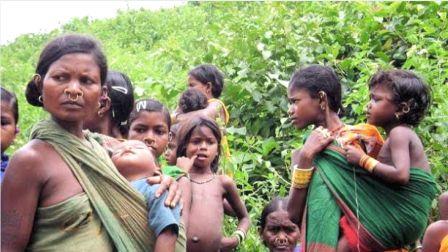 The tribals continue to be the most neglected sections of society. They are exploited by politicians, businessmen and contractors. The British had introduced certain schedules to prevent alienation of tribal land.
The tribals continue to be the most neglected sections of society. They are exploited by politicians, businessmen and contractors. The British had introduced certain schedules to prevent alienation of tribal land.
I do not know whether Murmu has taken part in any agitation to protect the interests of the tribals. The government’s anti-tribal attitude can be gauged from what it did to a Jesuit priest, Fr Stan Swamy, who had devoted his life to serving the tribals.
Stan Swamy lived with them like a tribal and did whatever he could to ameliorate their condition. He was branded an urban Naxalite, arrested and tortured to death. He is dead and gone but the government has not told the nation what crime he committed to deserve such a death.
There was a medical doctor from Bengal who loved the tribals so much that he and his wife lived with them and worked for them. He was arrested and kept in jail without bail for a long time. Worse, a Union Minister wrote a novel in which a doctor couple is projected as heinous characters. Her portrayal has striking resemblance to Dr Binayak Sen.
The Sangh Parivar has been cultivating the tribals in hundred and one ways. They have been introduced to practices, which were abhorrent to them. If Draupadi Murmu’s election encourages more and more tribals to assert their rights as citizens of a democracy, it is certainly commendable.
Let Murmu be given a pen, not a broom, so that she cannot just clean a small temple as shown in a video that went viral but install fellow tribals as priests in the modern temples of science and technology. She should always remember that once she is elected by the people, she is second to none, including the Prime Minister. ![]()
____________
Also Read:
Centre’s Opaque Auction Rules For Pulses Rip Off Govt Coffers, Help Millers Strike Rich
Need to amend laws like UAPA to provide for punishment for those who slap false cases
Global Arms Trade: Who are the real winners?
Why not 40 pc tickets for women in Punjab and elsewhere?
Punjab – How a deadly cocktail of Agri-Water-Energy nexus going to destroy it?

Disclaimer : PunjabTodayTV.com and other platforms of the Punjab Today group strive to include views and opinions from across the entire spectrum, but by no means do we agree with everything we publish. Our efforts and editorial choices consistently underscore our authors’ right to the freedom of speech. However, it should be clear to all readers that individual authors are responsible for the information, ideas or opinions in their articles, and very often, these do not reflect the views of PunjabTodayTV.com or other platforms of the group. Punjab Today does not assume any responsibility or liability for the views of authors whose work appears here.
Punjab Today believes in serious, engaging, narrative journalism at a time when mainstream media houses seem to have given up on long-form writing and news television has blurred or altogether erased the lines between news and slapstick entertainment. We at Punjab Today believe that readers such as yourself appreciate cerebral journalism, and would like you to hold us against the best international industry standards. Brickbats are welcome even more than bouquets, though an occasional pat on the back is always encouraging. Good journalism can be a lifeline in these uncertain times worldwide. You can support us in myriad ways. To begin with, by spreading word about us and forwarding this reportage. Stay engaged.
— Team PT


Copyright © Punjab Today TV : All right Reserve 2016 - 2024 |